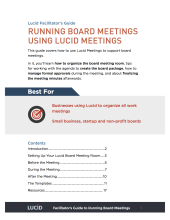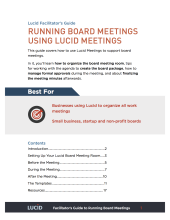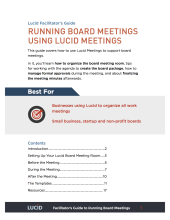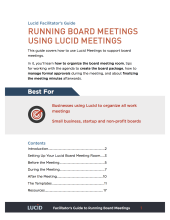You can find an introduction to Governance Cadence Meetings in Chapter 21 of Where the Action Is. These resources will help you plan, run, and troubleshoot the specific Governance Cadence Meetings your team needs.
Definition
A Governance Cadence Meeting is used to provide legal and strategic oversight for an organization or contractual relationship.
Questions Answered
- How did we perform?
- What’s changed?
- What needs our intervention?
Examples
- Board Meetings
- Quarterly Strategic Reviews
- QBRs (Quarterly Business Reviews between a vendor and client)
Purpose
- Strategic definition and oversight.
- Regulatory compliance and monitoring.
- Maintenance of relationships and organizational identity.
Work Outcomes
- Finalized decisions.
- Confirmation of strategic priorities.
- Legal oversight.
- Operational advice.
- Access to external resources.
Human Outcomes
- Clarity of direction.
- Mutual accountability and support.
- Improved situational awareness and contextual understanding.
Meeting Agenda Templates and Guides
How to Run a Board Meeting Using Robert's RulesElise Keith - Love, hate, hubris, and anxiety - Robert's Rules inspires strong feelings and opinions in those who have come to know them. Regardless of how anyone might feel about Robert's Rules, we still see this pillar of parliamentary procedure listed as the fall-back in board and organizational bylaws. If in doubt about how... [ more ] |
|
How to Run a Formal Board MeetingElise Keith - Boards have many responsibilities and must abide by certain rules and formalities, but there is no one set way to run a board meeting. For every board meeting, the directors must still determine what topics to prioritize, how to manage the available time, and how to ensure the board members arrive informed and stay... [ more ] |
|
How to Run a Simple Board MeetingElise Keith - Boards have many responsibilities and must abide by certain rules and formalities, but there is no one set way to run a board meeting. For every board meeting, the directors must still determine what topics to prioritize, how to manage the available time, and how to ensure the board members arrive informed and stay... [ more ] |
|
How to Run a Startup Board MeetingElise Keith - Boards have many responsibilities and must abide by certain rules and formalities, but there is no one set way to run a board meeting. For every board meeting, the directors must still determine what topics to prioritize, how to manage the available time, and how to ensure the board members arrive informed and stay... [ more ] |
Recommended Reading & Resources
Articles
- "10 Proactive Questions Every Board Member Should Be Asking," Andrew White, Tazim Essani, and Eric Wilkinson (2021)
- "Making great decisions," Chip Heath, Olivier Sibony (2013).
- Reid Hoffman's Rituals of Great Board Meetings: The 8 Strategic Tools Used by Top Companies on Coda
- "The Impact of Stress", Steve Bressert, Ph.D. (2016).
Blog Posts
- "The Secret to Making Board Meetings Suck Less," Jeff Bonforte.
Books
- Robert's Rules of Order Newly Revised, 11th Edition, by Henry M. Robert III, Daniel H. Honemann, Thomas J. Balch, et al.
- The Board Book: An Insider's Guide for Directors and Trustees. William G. Bowen (2012).
Glossary of Meeting Terms
Meeting Type
AGM stands for Annual General Meeting: A meeting of the general membership of an organization. AGMs are held by membership associations and large companies with shareholders according to the rules spelled out in the...
A Board Meeting is a formal meeting of the board of directors of an organization and any invited guests, held at definite intervals and as needed to review performance, consider policy issues, address major problems...
A committee consists of a named subgroup of people within an organization who come together to fill a predetermined function. A committee's work is described in its charter and is often conducted in a series of...
An executive session is a private meeting within an otherwise open meeting, such as an organizational board meeting. Boards may hold an executive session involving only board members to discuss sensitive or private...
General Term
The chair (also chairperson, chairwoman or chairman) is the highest elected officer of an organized group such as a board, a committee, or a deliberative assembly. In formal meetings, the chair is responsible for...
A motion is a formal proposal put to a group for a decision by vote in a meeting. Meetings that use Robert's Rules of Order or another parliamentary process make official decisions using motions. The outcome of a...
A notification is something written or printed that alerts people about an upcoming event, like an email that notifies participants about an upcoming meeting. Some formal meetings, such as board meetings, committee...
An observer is a meeting role granted by some organizations to non-members to allow them to monitor or participate in the organization's activities. Most commonly, observers rights in the meeting are restricted to...
Parliamentary Procedure is the body of rules, ethics and customs governing meetings and other operations of clubs, organizations, legislative bodies and other deliberative assemblies. Roberts Rules of Order documents...
A proxy is a representative that has been designated to vote on someone else's behalf in a meeting. The representative may be a member of the same voting body or external.
Quorum is a calculation of the minimum percentage of members who must be present at the meeting before business can be legally transacted. Formal meetings, such as board meetings and public meetings, must have a set...
Secretary is one of the defined roles in a formal meeting. The secretary’s role is to be the guardian of the process of meetings and the maintainer of the official business records. He or she often manages...
Many meetings use voting to evaluate group consensus and confirm decisions. Some votes are formal and binding, such as the votes on a motion during a board meeting or other meeting using parliamentary procedures....
Technique
A consent agenda is a technique for addressing multiple topics in a single agenda item, such as committee reports, meeting minutes, and other items that don't require discussion. Boards and committees use a consent...
Robert's Rules of Order is the most widely-used manual of parliamentary procedure in America. It governs the meetings of a diverse range of organizations—including church groups, county commissions, homeowners...
A straw poll is an ad-hoc or unofficial vote. Straw polls can be useful in meetings to quickly determine consensus. For example, if a conversation runs long, the leader may call a straw poll asking the group if most...



